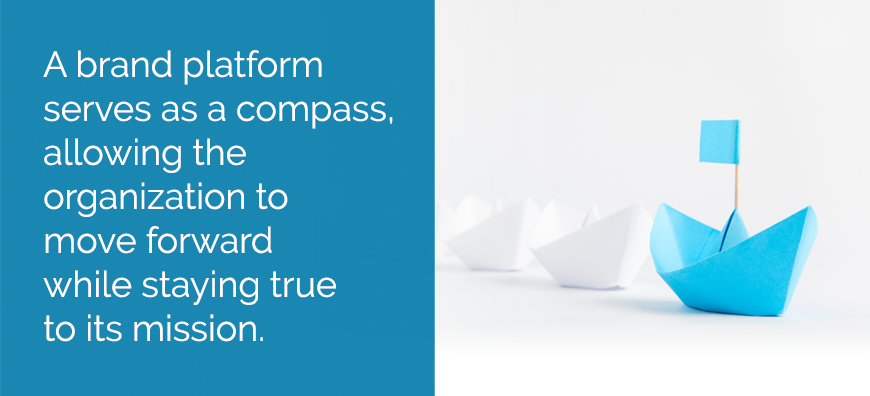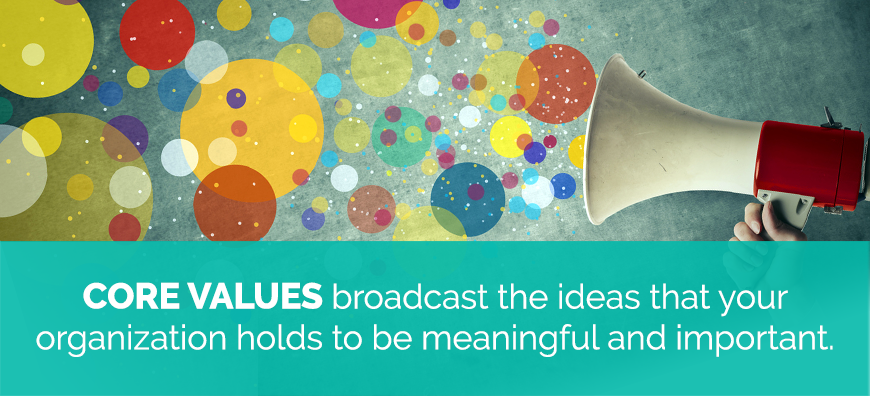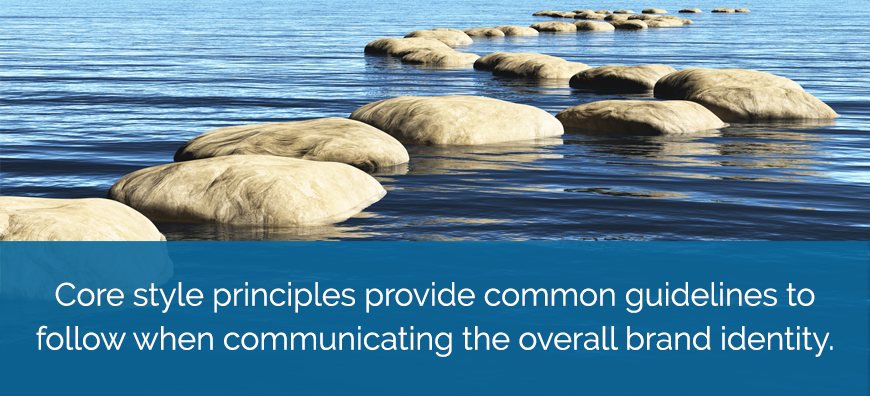
How to Build An Unforgettable Nonprofit Brand

We used to think of a “brand” as being about external or cosmetic factors, such as logos, colors and fonts. It was a visual signal to help external stakeholders recognize a company or organization, designed to project a certain image or conjure a particular emotion.
As marketing has become less unidirectional and more conversational and relational, the brand paradigm has shifted. Today’s brands must communicate the substance of an organization and build a shared sense of trust, purpose and value across all stakeholders.
That’s a big job for a brand—and for any communications leaders charged with developing, updating and protecting a brand identity. Fortunately, a framework and a suite of tools exist to help you build an unforgettable nonprofit brand.
The Framework: Nonprofit Brand IDEA
What constitutes a strong nonprofit brand today?
The modern nonprofit brand needs to “contribute to sustaining [the organization’s] social impact, serving their mission, and staying true to their values and culture,” write researchers Nathalie Laidler-Kylander and Christopher Stone. Over a period of 18 months, they set out to create a conceptual framework to help nonprofit communicators do just that. They interviewed 73 nonprofit executives, communication directors, consultants, and donors at 41 organizations. From that research, they created the Brand IDEA framework. IDEA stands for: brand integrity, brand democracy, brand ethics, and brand affinity:

- Brand integrity: The organization’s internal identity and external image are aligned with each other and with the mission.
- Brand democracy: offering real-world insights, case studies, or practical success stories that reflect your authority.
- Brand ethics: The brand itself and the way it is deployed reflect the core values of the organization.
- Brand affinity : providing credible, accurate content that fosters meaningful, lasting relationships with your audience.
Guided by these principles, nonprofits can shift away from a narrow approach to brand management and instead explore a more strategic role for their brands. They can pursue “broad, long-term social goals, while strengthening internal identity, cohesion, and capacity,” as Laidler-Kylander and Stone write.
Organizations need not only principles to guide their brand development, but concrete tools to help them actualize those principles. Below, I’ll describe some of the most important tools for nonprofit brand development.
The Nonprofit Brand Platform
The primary tool for developing an unforgettable nonprofit brand is the brand platform. The brand platform is an internal, living document that provides standardized language describing what the organization does, why you do it, who you do it for, and other essential information. The basic components of the brand platform are:
- Mission Statement
- Core Values
- Unique Value Proposition
- Key Messages
- Stakeholder Attitudes
- Core Style Principles
- Brand Style Guide
The brand platform serves as a compass, allowing the organization to move forward while staying true to its mission. By creating a brand platform guided by the IDEA Framework, you’re building your brand from the inside out. You’re also helping to build capacity, inspire action and maintain focus on the organization’s mission.

At Yodelpop, the brand platform is where we begin to help organizations build a “marketing organization” in preparation for carrying out a marketing program. In the process of providing input and approval for the brand platform, all internal stakeholders and departments come to agreement and commitment around a specific and detailed set of messages describing the organization.
- Internal stakeholders can internalize and feel a part of the brand platform, creating brand democracy.
- The brand platform aligns the core essence, mission and external identity of the organization, creating brand integrity.
- The brand platform articulates the core values behind the organization, actualizing brand ethics.
- The brand platform creates a roadmap for navigating the elements that build strong brand affinity.
The Framework: Nonprofit Brand IDEA
What constitutes a strong nonprofit brand today?
The modern nonprofit brand needs to “contribute to sustaining [the organization’s] social impact, serving their mission, and staying true to their values and culture,” write researchers Nathalie Laidler-Kylander and Christopher Stone. Over a period of 18 months, they set out to create a conceptual framework to help nonprofit communicators do just that. They interviewed 73 nonprofit executives, communication directors, consultants, and donors at 41 organizations. From that research, they created the Brand IDEA framework. IDEA stands for: brand integrity, brand democracy, brand ethics, and brand affinity:
Mission Statement
"A powerful mission statement articulates the … aspirational and often audacious outcome that an organization is pursuing."
— Chip Conley and Eric Friedenwald-Fishman, Marketing that Matters: 10 Practices to Profit your Business and Change the World
If your organization isn’t clear about its own mission, no one else will be either. Crafting or updating a mission statement is an act of soul searching. The objective is to truly convey what the organization is all about and create a shared sense of purpose.

The process of creating or updating an organization’s mission statement will be unique at each organization, and you should use tools and processes that resonate with your team. There are consultants who facilitate organizational development processes that include developing a mission statement. But there are good reasons to develop a mission statement in the context of developing or launching a marketing program. That way, the mission statement naturally leads to an organizational commitment to and investment in the marketing program, and the marketing is grounded in the mission.
If you’re leading the charge in revamping your mission statement, here are some tips:
- Make it a group effort. Hold brainstorming sessions for the whole team, or a retreat with an uninterrupted focus that invites opportunities for inspiration and reflection.
- Start by reflecting on your programs and services and what needs they meet, which other organizations do not. What value is being created? Here are some other questions to consider:
- What do we do? How do we do it?
- Whom do we do it for?
- What value are we bringing?
- What level of service or value do we provide?
- What three words or phrases would we use to describe our mission?
While the long-term goal articulated in your mission statement should be audacious and may be externally questionable, it should be regarded internally as not impossible. The more succinct, the better; "short in length and big in vision" is what Conley and Friedenwald-Fishman suggest.
Core Value
Core values act as your organization’s lighthouse. They broadcast the ideas that your organization holds to be meaningful and important, which undergird your mission and who you are. They play an important role in attracting qualified employees and volunteers as well as building trust with program participants and funders.

As an example, here are Yodelpop’s core values
- Everyone deserves to fulfill their unique potential.
- Work should be meaningful and fun.
- Good data plus creativity makes us unstoppable.
- Nonprofits deserve great marketing.
- Sustainable marketing is good business.
When we applied our process of creating core values to our own company, the result was a short set of belief statements that communicate our approach to relationships with clients, team members and other stakeholders: These core values help our audience understand who’s behind our brand and whether we’re the right fit for them. They set the tone for a relationship of trust and transparency with prospective employees, clients and partners.

For nonprofits, in addition to serving the above function and demonstrating value to members, donors, funders and other stakeholders, a value proposition creates a powerful association with the organization’s brand and serves as the essence of the marketing message.
A unique value proposition takes into consideration the goals and challenges of your audience that your organization is uniquely positioned to address.
Just as brands have evolved to convey a holistic identity of an organization, the unique proposition can convey the experience that you want donors, members and other stakeholders to associate with the brand.
Key Messages
Key messages are at the center of the brand platform, and define the who, what, why and how of what your organization does. This language is particularly critical in developing the organization’s main website content, as well as being crucial to all marketing and sales communications.
Key messages are where you plant the seeds for the development of your organization’s personas, another important marketing tool. As you create language about who your organization serves, and why, you become more prepared to describe those people, along with other key stakeholders, in specific and differentiated terms.
You can also tell the story behind the founding of the organization—the key players and their backgrounds, and those who supported the organization in its initial stages.
Why was the organization founded? What was the initial problem that it was created to solve? Has the purpose evolved since then? If so, then why?
It’s in the who and why sections that organizations first start telling their story in a way that creates connection, generates memory, and empowers sharing.
Finally, an important question to answer in the key messages is how the organization provides its value. Where is the organization based? How does it perform its work toward its mission? How does it deliver value to its stakeholders?
Stakeholder Attitudes
A good way to tell how well the brand platform is coming together in a concise and authentic way is to detail some of the attitudes or experiences that stakeholders have communicated. What is the emotional aftertaste that they’re left with after interacting with various touchpoints of the organization?
Start with testimonials. What have donors or members said about your organization and their experience with it? How has it helped them solve their problems or address their concerns? How do they feel about your organization?
You can document this as well for volunteers, employees and other partners as well.
Sharing these experiences in the brand platform will underscore the language you’ve worked hard to draft in the previous sections and validate the unique value of your organization that you’ve articulated.

This can be as simple as language describing acceptable shortened forms of the organization’s name. A tagline can be included, perhaps born out of the unique value proposition. Core style principles give internal stakeholders common guidelines to follow when they are communicating the overall brand identity.
Brand Style Guide
Now that you’ve positioned the messaging of the organization very clearly, it’s time to align this with the visual brand to create brand integrity and affinity.
A brand style guide is a separate document from the rest of the messaging elements of the platform described above. With the brand style guide, you are establishing trust and recognition by making sure that all the external facing brand and marketing assets are consistent with the important messaging documented in the brand platform.
While the key message platform will be an important guide and springboard for much of the content assets, including web copy, blog posts, pillar pages, and brochures, and provide the consistent voice that your audience will recognize, the brand style guide will tie these elements together with the visual identity, including:
- Logo (updated as needed)
- Brand colors
- Fonts
- Best practices for use of all marketing assets
The brand style guide leaves the guesswork out of what variations of the visual identity can be used, and where. It can let everyone know how not to use the visual elements, and best practices around the use of these elements in different mediums and platforms, saving time, money and conflict and making much of the operations of your organization more effective and efficient across communications.
Taking the time to develop the brand platform sets your organization up for success going forward. The organization can make decisions quickly and concisely across all departments. It removes the need for the vague assumptions that are often made in marketing and sales frameworks that otherwise don’t contribute well to the return on the investment of those activities.
As the expectations of brands have changed, not only for nonprofits but across all sectors, organizations have a tremendous opportunity to communicate who they are in a whole new way. With the IDEA Framework to guide brand development, and a set of tools to help put those principles into practice, no organization should be without an unforgettable brand.
Download a PDF of How to Build an Unforgettable Nonprofit Brand
.jpg)
